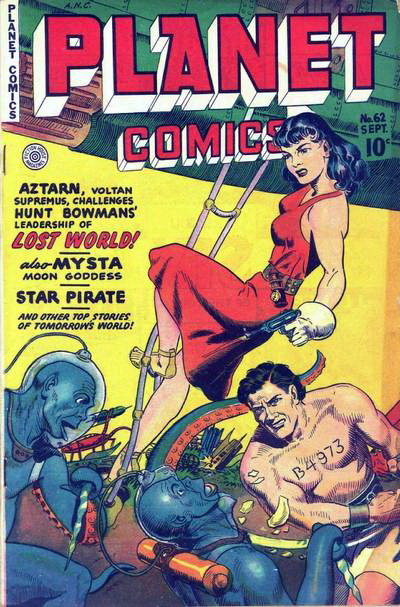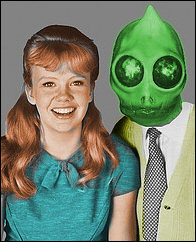 Planet Comics #62 (Sept 1949) is the final original Golden Age appearance of Mysta of the Moon. A stated previously, comic books and their content were changing and soon there would be little acceptance of grand, impossible space operas. The trend in newer storytelling would be just as bombastic and unlikely thematically but would be more acceptable in relation to what the public perceived as possible in science fiction tropes. Film and television would have a great influence on the appearence and plots of science fiction comics thereafter.
Planet Comics #62 (Sept 1949) is the final original Golden Age appearance of Mysta of the Moon. A stated previously, comic books and their content were changing and soon there would be little acceptance of grand, impossible space operas. The trend in newer storytelling would be just as bombastic and unlikely thematically but would be more acceptable in relation to what the public perceived as possible in science fiction tropes. Film and television would have a great influence on the appearence and plots of science fiction comics thereafter.
Planet Comics would mostly exist as a re-print anthology before ending in late 1953. While the serials ended with somewhat of a quiet whimper Planet Comics went out with a bang. The cover to the final issue, #73 (Winter 1953) is a Maurice Whitman classic. The lead feature, Cerebrex, is also no small accomplishment in both art and story. Cerebrex has been reprinted a few times over the decades and a few comic book blogs have also featured the tale of computer power gone right.
The last Planet Comics issue featuring Mysta starts to shake up the status quo a bit as another technician begins to delve into Mysta's true identity. For the uninitiated, Mysta is working undercover with the Safety Council, leaving behind her extra-planetary fortress and resident caretaker to live among humanity. The main plot is one typical of the last several chapters of Mysta and concerns a mutated race and the misuse of technology. It is a shame the series ended so abruptly because the subplot about Mysta's identity was interesting. It showed a growth of characterization in the serial that the rather disposable nature of the medium of the era was often bereft.
This chapter of Mysta of the Moon is shorter by one page than previous entries. The Mysta feature is also the only one among the other serials that signed off with a definite if unsatisfying conclusion. All the other series simply promised to return next issue and often did not reappear. I speculate that the creative team knew this chapter of Mysta would be the final one and wrapped it up very, very quickly even though many plot threads remained dangling, particularly in regards to Bron, exiled to Mysta's fortress moon. The final panel of the Mysta story depicts her breaking the fourth wall, an annoyed expression on her face. Indeed, throughout much of the story Mysta appears uncharacteristically bothered, unprepared and angry. In the final scene the reader is privy to her thoughts and she in effect communicates a final, perfunctory farewell to the audience. A text box in the panel displays the phrase 'The End!' something that the other serials did not include in their own final chapters. We may probably never know but it is as if the creators are expressing their own frustrations through Mysta.
But it is as a fan and not as a critic that I read Mysta and the other heroines of Planet Comics. As a reader of these Golden Age tales I am more of a Fan-Editor. In that certain way that comic book fans pick and choose what continuity or behind-the-scenes reality to keep or ignore I apply that same sensibility to Mysta, not allowing the changes at Fiction House that caused the various adventure features to conclude so abruptly. As a fan I can accept that Mysta, seeing no need to continue in her previous role as the final authority on the dissemination of science in a rebuilt human civilization would choose a form of semi-retirement. Instead of acting as a wrathful Science Goddess she would keep her hand in, acting as a government functionary while keeping watch via the Science Council. In abandoning her fortress on the moon Mysta is allowing humanity to once again control their own destiny and perhaps discover a new one of her own as well.
Mysta and the other Golden Age characters of Fiction House would vanish into obscurity until revived in the 1980s for a short-lived effort by Paragon Press called The Star-Fems, a time-tossed team of space-based heroines. You can find more info about the team and read the 1980 adventures of Mysta of the Moon, Futura and Gale Allen here: The Star Fems.
Monday, March 14, 2011
Mysta of the Moon - Chapter 28
Posted by
Sleestak
at
3/14/2011 11:00:00 PM
![]()
![]()
Labels: Mysta, mysta mondays, mysta of the moon, women in science fiction
Subscribe to:
Post Comments (Atom)

































Thanx for compiling this serial -- it was a fun ride!
ReplyDeleteDefinitely "old school" pulp in its sensibilities, particular re spaceship designs. By the end of WWII & public knowledge of the V2 rockets, the mass audience "knew" what a spaceship was supposed to look like. The colorful dirigible inspired designs of the 1920s & 30s that launched & landed horizontally succumbed to the vertical sleek steel finned shafts of the late 40s & 1950s. Only in the last few decades have fictional spaceships re-acquired their imaginative look.
Still, MYSTA was a good (albeit not great) example of the classic space opera.